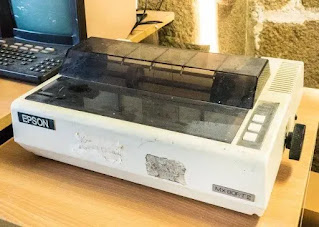Dot Matrix Printer
Dot matrix printers, the most traditional of old-school computer printers, use a pin or wire print head to press an ink ribbon against a piece of paper. A dot matrix printer is similar to the reams of paper with tear-off perforated holes on the side. Dot matrix printers, which are far less common nowadays, are typically quite robust and reliable. They're better suited for situations where a large amount of printing is required but quality isn't critical. They're also known to survive in harsher commercial environments where less expensive printers would fail.
A dot matrix printer is an impact printer that uses a fixed number of pins or wires to print. Pins or wires are typically arranged in one or more vertical columns. The pins make contact with an ink-coated ribbon and the paper, resulting in each pin leaving a small dot on the paper. The intersection of these dots results in a dot matrix image. Serial dot matrix printers were another name for them.
While inkjet and laser printers use dot matrix printing, they operate differently than impact "dot matrix printers" and can deposit ink or toner at higher dot resolutions more quickly and with less inherent noise. Unlike an inkjet or laser printer, an impact printer can make copies using multi-part forms.
History of Dot Matrix Printers
Dot matrix impact printers were widely considered to be the best combination of cost and versatility in the 1970s and 1980s, and were by far the most common type of printer used with personal and home computers until the 1990s.
The Centronics 101 was the first impact dot matrix printer. Introduced in 1970, it inspired the design of the parallel electrical interface, which became standard on most printers until it was supplanted by the Universal Serial Bus more than two decades later (USB).
Another major vendor was Digital Equipment Corporation (DEC), albeit with a focus on use with their PDP minicomputer line.
The first of many, the LA30 30 character/second (CPS) dot matrix printer, was introduced in 1970.
Another major vendor was Digital Equipment Corporation (DEC), albeit with a focus on use with their PDP minicomputer line. The first of many, the LA30 30 character/second (CPS) dot matrix printer, was introduced in 1970.
Due to their higher speed and versatility, dot-matrix printers began to outsell daisywheel printers in the mid-1980s.
Increased printhead pincount from 7, 8, 9, or 12 to 18, 24, 27, or 36 allowed for superior print quality, which was required for success in Asian markets to print legible CJKV characters. At 24/180 inch, Epson's 24-pin LQ-series has risen to become the new de facto standard (per pass - 7.5 lpi). A 24-pin printer could not only lay down a denser dot-pattern in a single pass, but it could also cover a larger area and print faster. Although the text quality of a 24-pin printer was clearly inferior to that of a true letter-quality printer, such as a daisy wheel or laser printer, the print quality was far superior to that of a 9-pin printer. 24-pin printers gradually replaced 9-pin printers as manufacturing costs fell.



